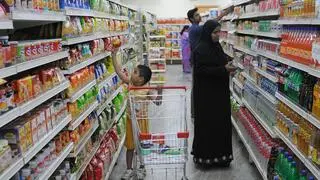Abhishek Law
At 23, Wharton-educated Shashwat Goenka was drafted into his father’s business, the RP Sanjiv Goenka Group, as head of retail, and in charge of the chain — Spencer’s.
It was 2013. The sales per square ft at Spencer’s then was barely ₹1,300 - ₹1,500, say sources. Despite its history and early entry into retail, Spencer’s struggled to get footfalls and posted losses. But by 2019, Spencer’s sales per sq ft had zoomed to over ₹17,500. The approximate sales per sq ft for rival D-Mart was ₹32,000 in 2019, and ₹12,500 for Big Bazaar, add sources. Acquisitions, focus on topline, format shifts all contributed to the turnaround.
Course correction
As a former employee puts it, with Shashwat’s entry, “the course correction for Spencer’s had begun”. The company returned a maiden net profit of ₹1.50 crore (on a stand-alone basis), for the quarter-ending December 31, 2018, and listed on the bourses on January 25, 2019. Months after listing, Spencer’s announced the acquisition of Nature’s Basket, the upmarket food retailer from the Godrej Group, for an all-cash deal of ₹300 crore.
“Within a two-year time frame, Nature’s Basket is already EBITDA positive for the first time in its history. It stood at ₹28 crore in FY21. Margins too improved,” Shashwat told Business Line .
Pandemic wrought havoc but business recovery last fiscal has been to the tune of 92 per cent of pre-Covid levels, Spencer’s said in its recent earnings presentation. “Despite recovery in non-food business not fully happening in Q4 of FY21, its profitability on a consolidated basis improved.” Spencer’s Retail reported a consolidated turnover of ₹2,428 crore last fiscal, an 8 per cent, YoY drop; while net loss widened YoY to ₹164 crore. More acquisitions on e-grocery and delivery verticals are on the cards with talks on with two players.
Shashwat brought about a concerted focus on hypermarket formats. There was also a plan to push “high margin offerings beyond food and groceries” — apparel and small appliances. Gourmet food, patisserie and bakery items were ramped up.
In-house brands were reworked into mass and premium offerings across categories such as beverages, staples and groceries, salty snacks and personal care. Today 78 per cent of Spencer’s topline is from essentials and FMCG offerings while 22 per cent is from merchandise including apparel.
From a food-only retailer, Spencer’s became a “food-first” retailer. Tough calls like exiting loss-making markets in western India were taken.
According to Shashwat, it was always about “growing the topline” while keeping a “conscious focus on profitability”. But he did want to ramp up store count.
Expansion route
Around ₹3 crore was pumped-in towards setting up of a new store, mostly hypermarkets between FY15 and FY19. Some 25-30 stores were added each year during this period.
The expansion began with Tier I markets, prominent high streets and as anchor stores in upcoming malls. Then it expanded into Tier-II locations with a supermarket format. “Even in a slowdown year, till the pandemic hit, we were adding 20-odd stores annually. So every year, around ₹30-50 crore was being continuously invested,” he says.
But the retail strategy went beyond store expansion.
“I could see that the future of modern retail was omni-channel — where we would need a strong online presence, a remote ordering and store pick-up option all this backed by a strong store network,” explains Shashwat.
The now 31-year-old spearheaded the first ever acquisition in 2015 buying the online grocery start-up, meragrocer.com . Not many app-based grocers were making money at that time as adoption was low. So Spencer’s took a big leap of faith as it started developing its own shopping app — for both Android and iOS. It paid off during the pandemic when footfalls at stores thinned. “In FY21, e-commerce business grew 250 per cent YoY,” Shashwat points out.
Online orders are app led at the moment for Spencer’s — at nearly 70 per cent; and the remaining through its website.
According to Abneesh Roy, Executive Vice President, Edelweiss Securities, Spencer’s has to create a niche for itself.
“In a country of 130 billion there cannot be just one or two players. So Spencer’s needs to identify and focus on its advantages,” he says. Currently, it’s the third largest modern retail player after D-Mart and Reliance Retail.
Although penetration remains low, the online grocery market has grown 30x in the last 7-8 years. But e-grocery is still just 4 per cent of the total market with enough scope of growth across players.
If required, promoters “may offload a minority stake” in both Spencer’s and Nature’s Basket to bring in investors with expertise in retail. “I want to focus on the opportunities rather than the problems,” Shashwat says, quoting an oft-repeated phrase of his father’s.







Comments
Comments have to be in English, and in full sentences. They cannot be abusive or personal. Please abide by our community guidelines for posting your comments.
We have migrated to a new commenting platform. If you are already a registered user of TheHindu Businessline and logged in, you may continue to engage with our articles. If you do not have an account please register and login to post comments. Users can access their older comments by logging into their accounts on Vuukle.